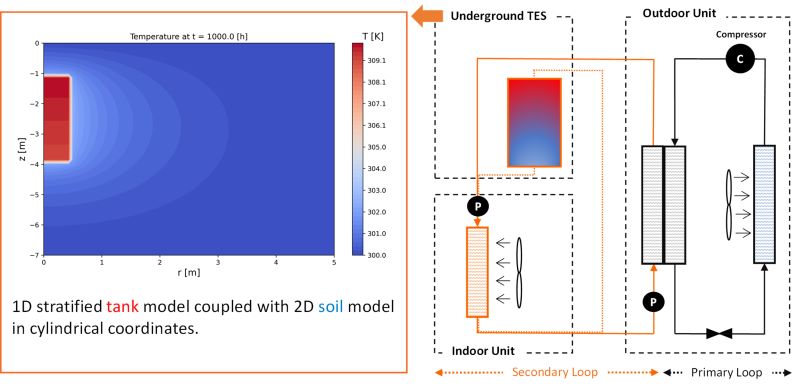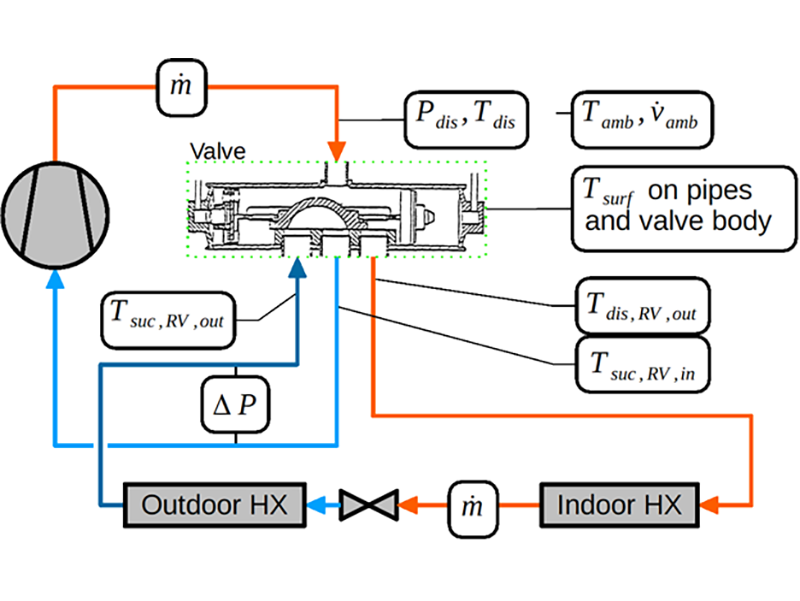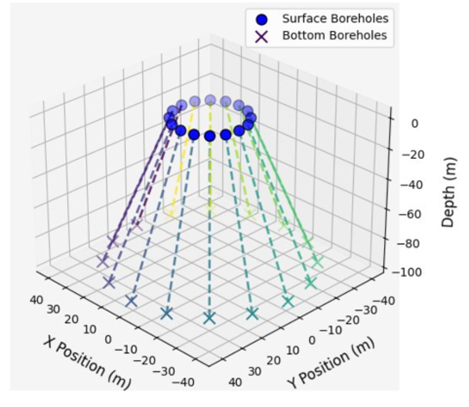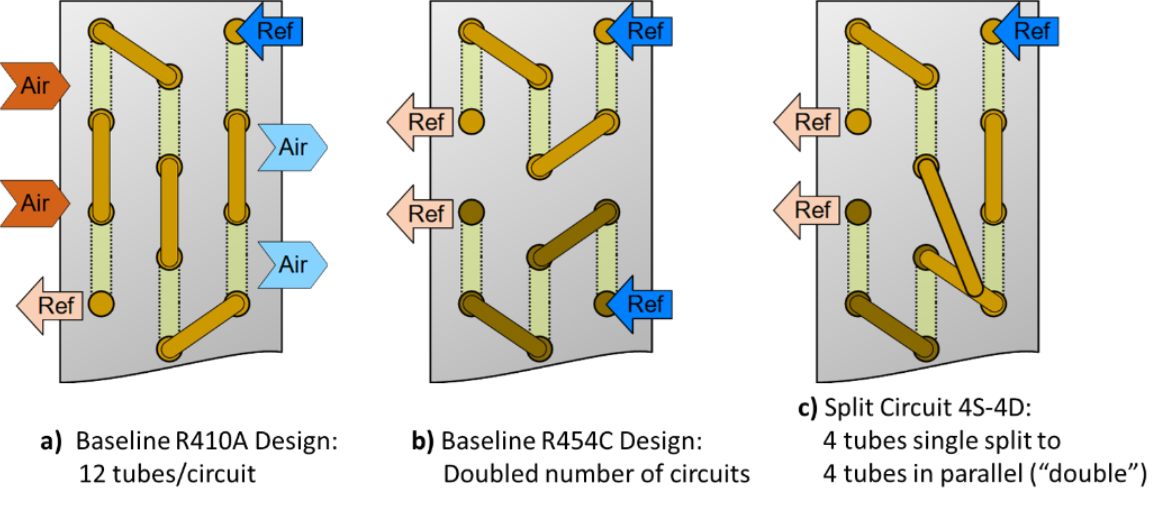CIBS Research
Explore the Research of CIBS2025
Benefits of Secondary Loop Systems: Thermal Storage and Demand Response
- Project Team: Students: Pouria Moghimi; Faculty: Jeffrey D. Spitler, Christian Bach
- Project Number: 23-06-3
- Goals: Field measurements of a residential-scale buried thermal energy storage tank that can be used for simulation validation. Use simulations to model thermal and economic performance of systems.
- Outcomes/Deliverables: This year, the anticipated outcomes are a field test of a buried TES tank, improved models and further insight into techno-economic feasibility
- Scholarship:
Moghimi, P., C.K. Bach and J.D. Spitler. 2024. Development and Experimental Validation of Simplified Numerical Models for Stratified Thermal Energy Storage Tanks Including Standby Storage Mode and Adverse Feed Temperatures. 20th International Refrigeration and Air Conditioning Conference. West Lafayette, Indiana. July 15-18. https://docs.lib.purdue.edu/iracc/2566
Moghimi, P., C.K. Bach and J.D. Spitler. 2024. Development of an underground stratified thermal energy storage tank model and performance comparisons with an above-ground tank. 20th International Refrigeration and Air Conditioning Conference. West Lafayette, Indiana. July 15-18. https://docs.lib.purdue.edu/iracc/2565
Moghimi, P., J.D. Spitler, and C.K. Bach. 2024. System and Component Model Development of a Secondary Loop System with Buried Thermal Energy Storage Tank. Proceedings of Enerstock 2024, Lyon, France. June 5-7, 2024. Paper 519772. https://doi.org/10.5281/zenodo.13784975
Solar-powered ultra-low-GWP heat pumps with DC compressors and TES
- Project Team: Students:Gabriel Parker; Faculty: Jeffrey D. Spitler, Christian Bach, Ardeshir Moftakhari
- Project Number: 23-07-3
- Goals: Field test of solar-powered heat pump system with thermal energy storage. Testing of rule-based control
- Outcomes/Deliverables: This year, the anticipated outcomes are experimental testing of the components, implementation of a DC compressor in our air-to-water heat pump, along with replacing the refrigerant with R1234yf
- Scholarship: N/A yet
Reversing Valve Loss and Leakage Models for Low Temperature Heat Pumps
- Project Team: Current students: Dipa Saha, Julfikar Ali, Rasheed Shittu Former student: Jacob Taylor Faculty: Christian Bach, Ardeshir Moftakhari
- Project Number: 24-01-2
- Goals: This project provides data for reversing valves for low-GWP refrigerants for cold climate heat pumps and semi-empirical models for pressure drop, heat loss, and leakage
- Outcomes/Deliverables: This project delivers a database of experimental reversing valve performance as well as models to be used in members simulation tools
- Scholarship: N/A yet
Physics-Based Models for Performance Analysis of Refrigerant-To-Water Heat Exchangers in Hydronic Heat Pump Applications
- Project Team: Students:Saqib Ayuob; Faculty: Ardeshir Moftakhari, Christian Bach
- Project Number: 24-06-2
- Goals: Project aims to provide new data and models for performance evaluation of a compact PCM thermal energy storage (TES) system for integration with hydronic heat pumps.
- Outcomes/Deliverables: This project will deliver: (1) experimental performance data for the PCM-TES lab prototypes; (2) a physics-based model to evaluate performance of PCM TES with heat pumps; and (3) analysis of load shifting potential of PCM-TES system when integrated with hydronic heat pumps.
- Scholarship: N/A yet
Development of Design Algorithms for Ground Heat Exchangers with Angled Boreholes
- Project Team: Students: Timothy West, Kahleen Dabbs Faculty: Jeffrey D. Spitler
- Project Number: 25-01
- Goals: This project aims to design algorithms that can generate and size ground heat exchangers with angled boreholes used with geothermal heat pump systems. Angled boreholes can reduce total drilling and surface disturbances due to drilling
- Outcomes/Deliverables: This project will deliver new design algorithms implemented in GHEDesigner that cover fan configurations, boreholes that are angled under existing buildings and circular configurations that are angled outwards from a single drill pad
- Scholarship: N/A yet
Generating in-system test data and semi-physics tunable models for performance metrics and injection flowrate for low-GWP fluids
- Project Team: Students: M. Hasanat Khan, Rasheed Shittu Faculty: Christian Bach, Ardeshir Moftakhari
- Project Number: 25-02
- Goals: This project aims to Develop a tunable, physics informed, model for injected compressors including injection flowrate as well as performance metrics
- Outcomes/Deliverables: This project will deliver measured performance data for several compressors for a range of conditions as well as a prototypical model
- Scholarship: N/A yet
Heat exchangers and for high-glide low-GWP refrigerants: effects of refrigerant glide and refrigerant quality maldistribution
- Project Team: Students: Mohammadreza Azaddel, Amr Ashraf, Carson Mckinney Faculty: Christian Bach, Ardeshir Moftakhari
- Project Number: 25-10
- Goals: This project aims to increase fin-tube heat exchanger capacity for fixed suction conditions by adjustment in refrigerant circuitry for R454C, a low-GWP fluid with substantial glide
- Outcomes/Deliverables: This project aims to deliver (1) Modified version of xFin for low superheat cases, (2) Simulations including quality maldistribution, and (3) Report of the results in the form of a journal paper
- Scholarship: N/A yet
CIBS Publications
- 2024 Publications
Mostafa, M. Z., K. Alghamdi, J. D. Spitler, C. K. Bach (2024). Performance Comparison of Different Circuitries for the TriCoil Three-fluid Heat Exchanger. International Refrigeration and Air Conditioning Conference at Purdue. Accepted Paper 2257.
Ghadiri, M., C. K. Bach, C. R. Bradshaw (2024). Effects of Splitter Placement on Fin-Tube Heat Exchanger Evaporator Performance. International Refrigeration and Air Conditioning Conference at Purdue. Accepted Paper 2218.
Moghimi, P., C. K. Bach, J. D. Spitler (2024). Development Of An Underground Stratified Thermal Energy Storage (TES) Tank ModelDevelopment of an underground stratified thermal energy storage tank model and performance comparisons with an above-ground tank. International Refrigeration and Air Conditioning Conference at Purdue. Accepted Paper 2275.
Moghimi, P., K. I. Alghamdi, C. K. Bach, J. D. Spitler (2024). Development And Experimental Validation Of Simplified Numerical Models For Stratified Thermal Energy Storage (TES) Tanks Including Storage Mode And Adverse Feed Temperatures. . International Refrigeration and Air Conditioning Conference at Purdue. Accepted Paper 2277.
Ismail, T., H. Ikram, A. Alexander, C. K. Bach (2024). Modeling the Effect of Non-uniform Frost Accumulation on the Performance of Heat Pump with Refrigerant side Flow Maldistribution. International Refrigeration and Air Conditioning Conference at Purdue. Accepted Paper 2361.
Ali, J., R. Siddharth, A. Alexander, C. K. Bach (2024). Development of Defrost Controller Platform for Commercial Rooftop Heat Pump Units. International Refrigeration and Air Conditioning Conference at Purdue. Accepted Paper 2430.
H. Ikram, T. Ismail, R. Siddharth, J. Ali, A. Alexander, C. K. Bach (2024). Insights Gained From The Experimental Testing Of A Rooftop Unit Under Frosting Conditions. International Refrigeration and Air Conditioning Conference at Purdue. Accepted Paper 2455.
- 2023 Publications
- 2022 Publications
Latif, H., Rahnama, S., Maccarini, A., Bradshaw, C. R., Nielsen, P., Hultmark, G., Afshari, A. 2022. Precision Ventilation for an Open-Plan Office: A Study of Variable Jet Interaction Between Chilled Beams. Sustainability 2022. 14, 11466.
Saleem, S., Bradshaw, C.R., Bach, C.K. 2022. Development of Design Guidelines for Fin-and-Tube Heat Exchangers with Low-GWP Refrigerants. International Journal of Refrigeration. 143 (2022) pp.166-181. (CIBS 21-05)
Saleem, S., Bradshaw, C.R., Bach, C.K. 2022. Performance assessment of R1234ze(E) as a low GWP substitute to R410A in fin-and-tube heat exchangers. International Journal of Refrigeration. 134 (2022) pp.253-264. (CIBS 21-05)
Tanveer, M., Bradshaw, C.R., Ding, X., Ziviani, D., 2022. Mechanistic Chamber Models: A Review of Geometry, Mass Flow, Valve, and Heat Transfer Sub-Models. International Journal of Refrigeration. 142 (2022) pp.111-126.
Orosz, J., Kemp, G., Bradshaw, C.R., Groll, E.A., 2022. Updated Performance and Operating Characteristics of a Novel Rotating Spool Compressor. In: Proceedings of the International Compressor Engineering Conference, Purdue University, West Lafayette, IN, USA. No 1119.
Tanveer, M., Bradshaw, C.R., Ding, X., Ziviani, D., 2022. Mechanistic Chamber Models: A Review of Geometry, Mass Flow and Heat Transfer Sub-Models and an Outlook to Future Research. In: Proceedings of the International Compressor Engineering Conference, Purdue University, West Lafayette, IN, USA. No 1180.
Saleem, S., Bradshaw, C.R., Bach, C., 2022. R1234ze(E) as a Low-GWP Replacement of R410A in Fin-and-Tube Evaporators. In: Proceedings of the International Refrigeration Engineering Conference, Purdue University, West Lafayette, IN, USA. No 2193. (CIBS 21-05)
Islam, M., Nicholas, J., Bradshaw, C.R., 2022. Development and Experimental Validation of a Mechanistic Chamber Model of a Novel Peristaltic Compressor. In: Proceedings of the International Compressor Engineering Conference, Purdue University, West Lafayette, IN, USA. No 1210.
Khan, A., Bradshaw, C.R., 2022. Quantitative Comparison of the Performance of Vapor Compression Cycles with Various Means of Compressor Flooding. In: Proceedings of the International Compressor Engineering Conference, Purdue University, West Lafayette, IN, USA. No 1227.
Ghadiri, M., Bach, C., Bradshaw, C.R.„ 2022. R468C as a Low-GWP Replacement of R410A in Fin-and-Tube Evaporators. In: Proceedings of the International Refrigeration Engineering Conference, Purdue University, West Lafayette, IN, USA. No 2262. (CIBS 21-05)
Lee, A., Bach, C., Bradshaw, C.R.„ 2022. Differential Mass Evacuation Sampling Method for Measuring Refrigerant Charge in Round Tube Plate Fin Heat Exchangers (ASHRAE RP-1785). In: Proceedings of the International Refrigeration Engineering Conference, Purdue University, West Lafayette, IN, USA. No 2273.
Gabel, K., Bradshaw, C.R., 2022. Evaluation And Quantification Of Semi-Empirical Compressor Model Predictive Capabilities Under Modulation And Extrapolation Scenarios. In: Proceedings of the International Compressor Engineering Conference, Purdue University, West Lafayette, IN, USA. No 1318. (CIBS 21-11)
Tanveer, M., Bradshaw, C.R., Orosz, J, Kemp, G., 2021. Optimum Spool Compressor Aspect Ratio for R134a and R1234ze(E). In: Proceedings of the International Compressor Engineering Conference, Purdue University, West Lafayette, IN, USA. No 1379.
Yousaf, S., Bradshaw, C.R., Kamalapurkar, R., San, O., 2022. Physics Informed Machine Learning Based Reduced Order Model of Unitary Equipment. In: Proceedings of the International Refrigeration Engineering Conference, Purdue University, West Lafayette, IN, USA. No 2386. (CIBS AR-042)
Waikar, A., Rowinski, D., Kemp, G., Orosz, J., Bradshaw, C.R., 2022. Modeling a Spool Compressor Using a Coupled Fluid And Solid Solver With Cut-Cell Based CFD Methodology With Adaptive Mesh Refinement. In: Proceedings of the International Compressor Engineering Conference, Purdue University, West Lafayette, IN, USA. No 1140.
(CIBS 22-05)
(CIBS AR21-037)
- 2021 Publications
Saleem, S., Bradshaw, C.R., Bach, C.K., 2021. Validation of a multi-circuit heat exchanger model for evaluating the effect of refrigerant circuitry on cross-fin conduction in evaporator mode . International Journal of Refrigeration. 131 (2021) pp.623-633. (CIBS 21-05)
Islam, M., Tubbs, C., Bengs, C, Bradshaw, C.R.„ 2021. Development of a Reconfigurable Prototype Peristaltic Compressor. In: IOP Conference Series: Materials Science and Engineering: International Conference on Compressors and their Systems. 1180.
Liu, X., J. D. Spitler, M. Qu and L. Shi. 2021. Recent Developments in the Design of Vertical Borehole Ground Heat Exchangers for Cost Reduction and Thermal Energy Storage Journal of Energy Resources Technology 143(10).
(CIBS 22-05)
Yarborough, S., Bradshaw, C.R., Orosz, J., Kemp, G. 2021. Empirical Indicated Loss Analysis of a
Tanveer, M., Bradshaw, C.R. 2021. Performance Evaluation of Low-GWP Refrigerants in 1-100 ton
scroll compressors. International Journal of Refrigeration. 129 (2021), pp.317-331.
Islam, M., Tubbs, C., Bengs, C, Bradshaw, C.R.„ 2021. Development of a Reconfigurable Prototype
Peristaltic Compressor. IOP Conference Series: Material Science Engineering. Vol. 1180. 012046.
Tanveer, M., Bradshaw, C.R.„ 2021. Scaling Method for Scroll Compressor Geometry Based on
Manufacturing and Performance Constraints. In: Proceedings of the International Conference on
Compressors and their Systems, City University, London, UK.
Tanveer, M., Bradshaw, C.R.„ 2021. Performance Evaluation of low-GWP Refrigerants in 1-100
Ton Scroll Compressors. In: Proceedings of the International Conference on Compressors and their
Systems, City University, London, UK.
Lee, A., Bach, C., Bradshaw, C.R.„ 2021. Differential Mass Evacuation Sampling Technique for
Measuring Refrigerant Charge and Oil Retention of Round Tube Plate Fin Heat Exchangers
(ASHRAE RP-1785). In: Proceedings of the International Refrigeration Engineering Conference,
Purdue University, West Lafayette, IN, USA. No 2124.
Saleem, S., Bradshaw, C.R.„ 2021. The Thermodynamic Behavior Of Low-GWP Zeotropic
Mixtures On Water-Source Heat Pump Equipment. In: Proceedings of the International
Refrigeration Engineering Conference, Purdue University, West Lafayette, IN, USA. No 2151.
Saleem, S., Sarfraz, S. Bach, C., Bradshaw, C.R.„ 2021. A Novel Experimental Infrastructure for
Collecting High-Fidelity Experimental Data for Refrigerant to Air Heat Exchangers. In:
Proceedings of the International Refrigeration Engineering Conference, Purdue University, West
Yarborough, S., Bradshaw, C.R., Orosz, J, Kemp, G., 2021. Empirical Indicated Loss Analysis of a
Semi-hermetic Light-Commercial Spool Compressor . In: Proceedings of the International
Compressor Engineering Conference, Purdue University, West Lafayette, IN, USA. No 1236.
Tanveer, M., Bradshaw, C.R.„ 2021. Quantitative and Qualitative Evaluation of Various
Positive-Displacement Compressor Modeling Platforms. In: Proceedings of the International
Compressor Engineering Conference, Purdue University, West Lafayette, IN, USA. No 1248.
Islam, M., Bradshaw, C.R.„ 2021. Development of Mechanistic Chamber Model of a Novel
Peristaltic Compressor for Air-conditioning and Refrigeration Applications. In: Proceedings of the
International Compressor Engineering Conference, Purdue University, West Lafayette, IN, USA.
- 2020 Publications
Tanveer, M., Bradshaw, C.R. 2020. Quantitative and Qualitative Evaluation of Various
Positive-Displacement Compressor Modeling Platforms. International Journal of Refrigeration.
Sarfraz, O., Bach, C.K., Bradshaw, C.R. 2020. Validation of advanced fin-and-tube heat exchanger
models with cross-fin conduction functionality. International Journal of Refrigeration. 116 (2020),
Lee, A., Bach, C.K., Bradshaw, C.R. 2020. Differential Mass Evacuation Sampling Technique for
Measuring Oil Retention and Refrigerant Charge of Round Tube Plate Fin Heat Exchangers
(ASHRAE RP-1785). Science and Technology for the Built Environment. 26 (2020), pp.790-804.
Saleem, S., Sarfraz, O., Bach, C.K., Bradshaw, C.R. 2020. Development of novel experimental
International Journal of Refrigeration. 114 (2020), pp.189-200.
Singleton, J., Schmidt, D. Bradshaw, C.R. 2020. Control and commissioning of a hot-gas bypass
compressor load stand for testing light-commercial compressors on low-GWP refrigerants.
International Journal of Refrigeration. 112 (2020), pp.82-89.
- 2019 Publications
Sarfraz, O., Bach, C.K., Bradshaw, C.R. 2019. A novel technique for computationally efficient
consideration of cross-fin conduction in fin-and-tube heat exchanger models. International Journal
of Refrigeration. 107 (2019), pp.73-83
Lee, A., Bach, C., Bradshaw, C.R., 2019. Study of Heat Exchanger Inlet Air Velocity Distribution
for Ducted Tests in a Psychrometric Chamber (ASHRAE RP-1785) . In: ASHRAE Transactions,
Atlanta. Vol 125 (2019). pp. 198-205.
Sarfraz, O., Bach, C.K., Bradshaw, C.R. 2019. Reduced order modeling for multi-circuit
fin-and-tube heat exchangers with multiple identical circuit types. International Journal of
Refrigeration. 106 (2019), pp. 236-247.
Sarfraz, O., Bach, C.K., Bradshaw, C.R. 2019. Discrete modeling of fin-and-tube heat exchangers
with cross-fin conduction functionality. International Journal of Refrigeration. 104 (2019), pp.
Schmidt, D., Singleton, J., Bradshaw, C.R. 2019. Development of a Light-Commercial Compressor
Load Stand to Measure Compressor Performance using Low-GWP Refrigerants. International
Journal of Refrigeration. 100(April 2019), 443-453.
Singleton, J., Schmidt, D. Bradshaw, C.R., 2019. Control and Commissioning of a Hot Gas Bypass
Compressor Load Stand for Testing Light-Commercial Compressors on Low-GWP Refrigerants .
In: 11th International Conference on Compressors and their Systems, City University, London,
Lee, A., Bach, C., Bradshaw, C.R., 2019. Study of Heat Exchanger Inlet Air Velocity Distribution
for Ducted Tests in a Psychrometric Chamber (ASHRAE RP-1785) . In: ASHRAE Transactions,
Atlanta. Vol 125 (2019). pp. 198-205.
- 2018 Publications
Sarfraz, O., Bach, C., Bradshaw, C.R. 2018. A Literature Review of Numerical Modeling
Techniques for Vapor Compression Systems with Focus on Heat Exchanger Modeling. In:
Proceedings of the International Refrigeration and Air Conditioning Conference, Purdue University,
West Lafayette, IN, USA. No 2439.
Schmidt, D., Singleton, J., Bradshaw, C.R., 2018. Development of a light-commercial compressor
load stand to measure compressor performance using low-GWP refrigerants. In: Proceedings of the
International Compressor Engineering Conference, Purdue University, West Lafayette, IN, USA.
Lee, J., Bach, C., Bradshaw, C.R., 2018. Experimental validation of refrigerant charge models in
coils for residential split systems. In: Proceedings of the International Refrigeration and Air
Conditioning Conference, Purdue University, West Lafayette, IN, USA. No 2670.







